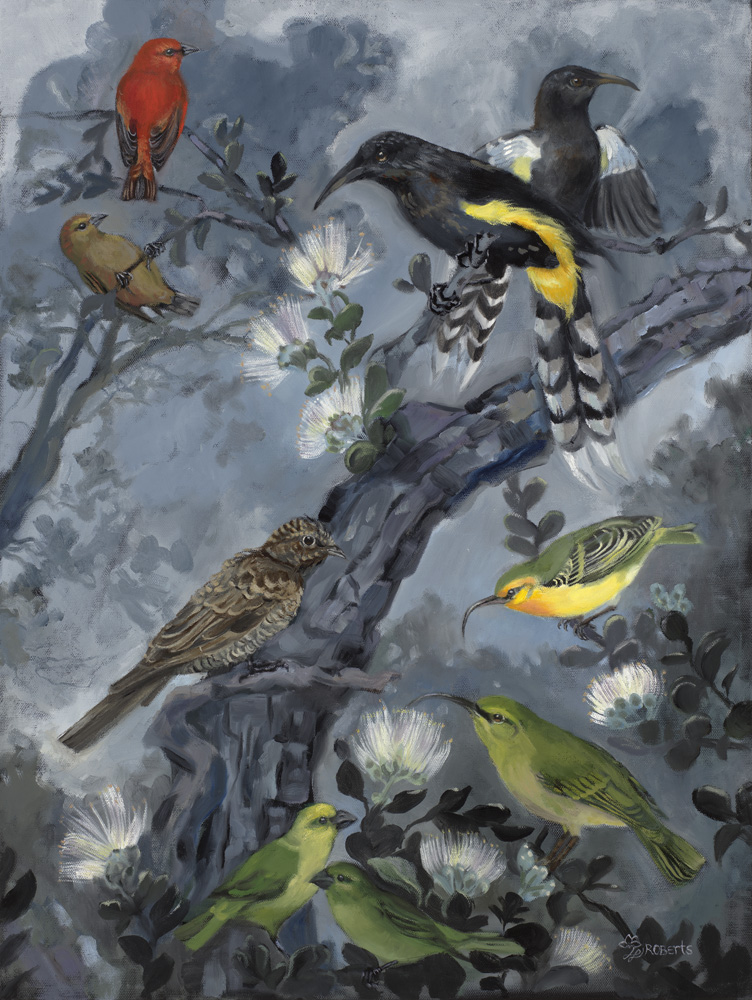
The Lost Forest of O’ahu
18 x 24 inches
Oil on Canvas
“The Lost Forest of O’ahu” shows 6 species of forest birds that exclusively lived on Oahu that have gone extinct. These exact types of birds were found no where else in the world, not even on the other islands. There was enough evolutionary drift to make them each a unique subspecies with noticeable differences between islands in the Hawaiian chain. Each of these birds were in existence with humans for at least a short time (no fossil-record-only birds), and unfortunately all were lost as a result directly or indirectly of human activity. It’s a bit sobering, but also beautiful to see them represented in one painting.
Left to right, top to bottom: Oahu Akepa, Oahu O’o, Amaui, Oahu Nukupuu, Oahu Akialoa, and Oahu Lesser Koa Finches
I included the male and female akepa, o’o, and finches. I worked from Cornell University’s birding field notes archive, plus the work of contemporary illustrators from the 1800s. It took a lot of research to do this painting.
All the birds are perched in an ohia tree, one of the most common trees of the Hawaiian native tree canopy in the forest. The ohia lehua (blossoms of the ohia tree) are the white kind, which is a legendary color of ohia. People claim they used to see it deep in the forests long ago, but no one can prove it ever existed, so in a sense, it is lost too.
HOW CAN WE HELP?
I wanted for anyone who feels moved by this painting to be able to make a difference in the efforts to keep and hopefully increase the birds we still have. Bret Nainoa Mossman (@birds_hawaii_pastpresent), a talented bird photographer and expert in conservation was kind enough to make a list of recommendations that I would like to share with you. Aside from watching over local areas for opportunities to support conservation, you can use the following list to specifically impact Hawaiian birds and their habitat.
DONATIONS
The easiest aspect of bird survival to influence right now is controlling or eradicating the invasive mosquito. Mosquitos were not in the islands until humans accidentally introduced them. Decreasing the mosquito population helps the birds by expanding the habitat where they can live without the risk of avian pox which is very deadly.
UH Hilo Mosquito Lab Fund: Research and development of mosquito control
Conservation Council for Hawai’i: Focusing on coordination and outreach https://www.conservehawaii.org/
American Bird Conservancy Hawai’i: Also focusing on coordination and outreach. If you would like to know more about what the current technique is for mosquito control, there is a summary on this page)
https://abcbirds.org/program/hawaii/mosquitoes/
A donation to any of those three organizations will have a positive impact on the survival of the remaining Hawaiian birds.
VOLUNTEER OPPORTUNITIES
If you live on one of the affected islands, you could get involved firsthand in conservation.
From Bret Nainoa Mossman: ” As far as volunteering goes it really depends on your level of experience and which island you are on but for Hawaiʻi Island, Palila needs the most help so volunteering with the Maunakea Forest Restoration Project is a good bet. Another great one is Friends of Hakalau. The restoration efforts on the refuge have really helped boost endangered bird numbers. These are my top recommendations for benefiting forest birds.”
Each island has opportunities for volunteer work.
HAWAI’I ISLAND
Maunakea Restoration Project:
https://dlnr.hawaii.gov/restoremaunakea/
Friends of Hakalau: Donations or volunteer work welcomed https://friendsofhakalauforest.org/
KAUAI ISLAND:
Kauai Island Forest Birds Recovery Project
https://kauaiforestbirds.org/
MAUI ISLAND:
Maui Forest Birds Recovery Project
https://mauiforestbirds.org/
OAHU:
Pacific Rim Conservation
https://pacificrimconservation.org/